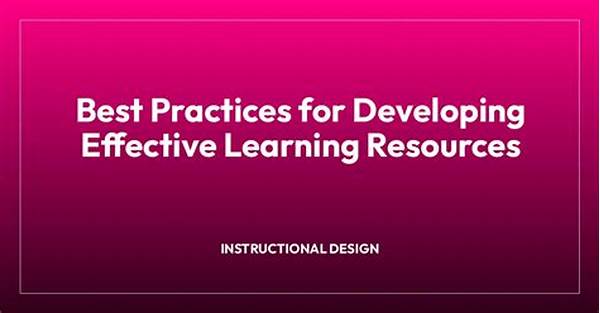Developing effective learning resources is a pivotal aspect of modern education systems. As educational needs evolve, the importance of creating resources that are not only informative but also engaging and easy to use becomes increasingly critical. Educators and content creators are continually challenged to design materials that cater to diverse learning styles, levels of understanding, and technological abilities. This article explores various approaches and considerations crucial for developing effective learning resources, providing a comprehensive guide to enhance educational outcomes.
Read Now : Best Academic Research Databases For Students
Key Principles in Developing Effective Learning Resources
The process of developing effective learning resources begins with understanding the learner’s needs and the educational objectives. The resources must align with curriculum standards and be accessible to a wide range of students, including those with special educational needs. Integrating multimedia elements, such as videos and interactive activities, can enhance engagement and cater to different learning styles.
Furthermore, the content must be accurate, up-to-date, and relevant, ensuring that it provides real-world applications and demonstrates its significance beyond the classroom. Developing effective learning resources also involves regular feedback and evaluation from both educators and learners. This feedback loop allows for continual improvement and adaptation to changing educational environments.
Finally, collaboration among educators, instructional designers, and subject matter experts plays a crucial role in the success of educational resources. Collaborative efforts ensure that the developed materials are comprehensive, effectively covering the required topics while maintaining clarity and understanding. These principles form the foundation of developing effective learning resources that empower educators and inspire learners.
Techniques for Developing Effective Learning Resources
1. Needs Assessment: Understanding learners’ requirements and gaps is critical in developing effective learning resources that are tailored to facilitate meaningful learning experiences.
2. Technological Integration: Leveraging technology, such as e-learning platforms and apps, enhances accessibility and enriches the learning experience, making resources more engaging and interactive.
3. Scalability: Developing effective learning resources involves designing materials that can be easily adapted for different educational settings and audiences, ensuring wide applicability.
4. Feedback Mechanisms: Implementing regular feedback processes allows educators to refine resources based on learner responses and changing educational trends, leading to continuous improvement.
5. Collaborative Design: Collaborative efforts between educators and designers ensure that resources are well-rounded, comprehensive, and cater to the goals of both teaching and learning.
Challenges in Developing Effective Learning Resources
Despite the potential benefits, developing effective learning resources comes with its own set of challenges. One notable challenge is addressing the diversity of learning environments and the varied technological capabilities of institutions. Not all learners have equal access to digital tools, posing barriers to the efficacy of technologically integrated resources. Therefore, developers must consider multiple formats and alternative solutions to bridge this gap.
Moreover, ensuring content accuracy and relevance requires dedicated effort and expertise. Changes in curricula, advancements in knowledge, and shifting pedagogical strategies can quickly render resources outdated. This necessitates a proactive approach to resource development, where continuous updates and revisions are pivotal. Effective project management and editorial oversight are essential in maintaining the quality and utility of these resources, ensuring they remain beneficial and aligned with educational goals.
Strategies to Optimize Resource Development
1. Engage Stakeholders: Involving educators, students, and industry professionals in resource creation enriches the content, making it more applicable and acceptable.
2. Use Empirical Research: Developing effective learning resources relies heavily on evidence-based strategies that have been tested to improve learning outcomes effectively.
3. Adaptability: Resources should allow for customization to meet specific learning objectives and cater to different student capabilities and advancements.
Read Now : Confidence Intervals For Sampling
4. Piloting and Testing: Initial resource prototypes should undergo rigorous testing in controlled environments to identify areas for improvement before widespread implementation.
5. Sustainability Practices: Employing sustainable practices in resource development ensures longevity, cost-effectiveness, and minimal environmental impact.
6. Interdisciplinary Approach: Bringing perspectives from various disciplines can contribute to a multidimensional and richer resource development process.
7. Creative Use of Media: Utilizing various forms of media creatively can help capture interest and address different learning modalities effectively.
8. Fostering Inclusivity: Resources should be inclusive, allowing all learners, regardless of ability, to access and benefit from the material.
9. Assessment Alignment: Resources need to be closely aligned with learning assessments to ensure they adequately prepare students for evaluations.
10. Professional Development: Ensuring educators are trained in using new resources maximizes their potential and promotes successful implementation in classrooms.
Long-Term Impact of Effective Learning Resources
Developing effective learning resources not only impacts immediate educational outcomes but also has long-lasting benefits for both educators and learners. Resources that are well-constructed and thoughtfully designed can lead to improved learner engagement, better retention of information, and higher academic achievement. They also foster an environment of lifelong learning, where students acquire skills that extend beyond traditional academic boundaries.
For educators, using effective resources reduces the time and effort needed to prepare lessons, allowing them to focus more on facilitating and personalizing learning experiences. Furthermore, as new teaching strategies emerge, adaptable resources provide educators with the flexibility to incorporate these approaches seamlessly, ensuring that their teaching remains relevant and effective.
Conclusion
In conclusion, the development of effective learning resources is an intricate yet rewarding endeavor. By prioritizing the needs of learners, integrating technology, ensuring scalability, and maintaining open channels for feedback, we can create resources that not only meet the current educational demands but also anticipate future needs. Through collaboration and continual refinement, developing effective learning resources has the potential to transform education, creating more impactful learning experiences and contributing significantly to the advancement of society as a whole.
